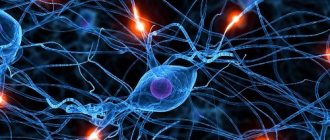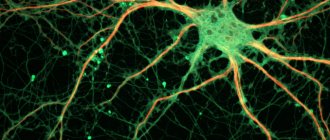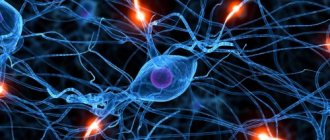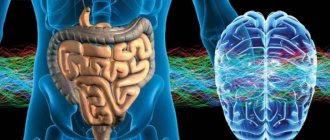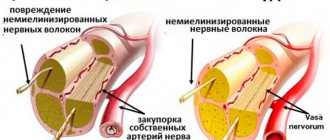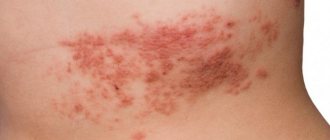With the exception of rare medical cases, almost every person experiences pain at least once in their life. The nervous system is responsible for them. An unpleasant feeling of pain causes irritation or inflammation of the nerve endings. It can occur against the background of an infection entering the body, due to muscle spasm that compresses blood vessels, etc. Although often inflammation is only a signal indicating the presence of a serious disease in the body.
Often the causes of illness are hypothermia, drafts, and previous injuries - these are sources of primary inflammation. Secondary occurs against the background of certain diseases.
Symptoms of inflammation of nerve endings
Before starting a diagnosis and prescribing treatment, the patient should describe his symptoms and sensations to the doctor in as much detail as possible. The main sign of inflammation is pain, the source of which cannot always be identified independently. It can get worse at night, with any physical activity, even walking, sometimes in the cold.
The second most characteristic sign indicating that there is inflammation of the nerve endings in the body is burning and tingling in the affected area. Depending on the area of pathology, pain can occur even with minor skin irritations.
In general, all symptoms depend on the area of the body in which the damage occurs. For example, when the nerve endings of the legs become inflamed, the sensitivity of the foot or lower leg worsens. Often movements in the knee area are severely limited and the slightest change in position causes pain. In case of eye disease, pain makes itself felt when moving the eyeballs, and vision often decreases.
Abstract
The central regulatory systems include: nervous, humoral (endocrine) and immune. The nervous system is a set of various structures of nervous tissue that regulate the activities of all organs and systems of the body, communicate between organs and the body as a whole with the external environment.
The nervous system carries out nervous regulation of body functions , participating in maintaining homeostasis; provides mental processes (learning, speech, memory, thinking, etc.) that allow not only learning, but also changing the external environment.
Nerve cell. Nerve fibers
The main structural and functional element of the nervous system is the neuron ( nerve cell ). Consists of a body and processes extending from it: dendrites and axons , which form nerve fibers (see.
"Animal tissue") Dendrites (short tree-like branching processes) provide perception of irritation and transmission of excitation to the neuron body.
An axon is the most powerful and longest (up to 1 m) non-branching process that conducts nerve excitation from the neuron body to other nerve cells or various organs.
Neurons are divided into:
- sensitive (receptor, afferent), which transmit excitation from receptors in the central nervous system (CNS);
- intercalary (intermediate), which transmit excitations within the central nervous system, connect nerve cells to each other, and make up the bulk of the central nervous system;
- motor (effector, efferent), which transmit impulses to the working organs.
Clusters of neuron cell bodies outside the CNS are called ganglia . Nerves are bundles of nerve fibers that extend beyond the central nervous system and give numerous branches to all organs, enclosed in a common connective tissue sheath. They are divided into sensitive, motor and mixed .
Nerve endings are the terminal (end) parts of nerve fibers.
Sensitive nerve fibers end in organs with receptors that perceive stimuli from the external or internal environment of the body, convert them into nervous excitation, and then transmit it to the central nervous system. Motor nerve fibers end in effectors that transmit excitation to the working organ (muscle, gland).
Synapses are specialized contacts between excitable cells that serve to transmit and transform nerve impulses. The synapse is divided into a presynaptic part (axon terminal), a synaptic cleft, and a postsynaptic part (a section of a neuron, muscle or secretory cell).
Signal transmission is carried out by an electrical (electrical synapses), humoral (chemical synapses, more common) mechanism, or a combination of both.
In chemical synapses, the presynaptic part contains synaptic vesicles with mediators (norepinephrine, acetylcholine, serotonin, gamma-aminobutyric acid, etc.). An incoming nerve impulse excites the presynaptic membrane and causes the release of a transmitter.
The transmitter entering the synaptic cleft reaches the postsynaptic membrane and causes the formation of an impulse in it. Through synapses, nerve impulses are transmitted in only one direction.
Scheme. Human nervous system. Basic principles
The regulatory activity of the nervous system is based on reflexes
Reflex is the body’s response to irritation, carried out and controlled by the nervous system.
Reflexes are important for maintaining the functional integrity of the body and the constancy of its internal environment ( homeostasis ); they also ensure the effective interaction of the body with the external environment.
Reflexes are divided into unconditioned (innate, genetically fixed) and conditioned (individually acquired).
The implementation of the reflex is associated with the reflex arc - the path along which excitation passes during the reflex.
The reflex arc consists of a receptor (nerve ending that perceives irritation); sensitive nerve fiber (transmits impulses from receptors to the central nervous system); the nerve center located in the central nervous system (a set of interneurons that ensure switching of excitation from sensory neurons to motor ones); motor nerve fiber motor neurons (transmit impulses from the central nervous system to the working organs); working organ (muscle, gland, etc.) A prerequisite for the implementation of a reflex is the integrity of all parts of the reflex arc.
Structure of the nervous system
Anatomically, the nervous system is divided into
Functionally, the nervous system is divided into:
- somatic , innervating striated muscles and sensory organs;
- vegetative (autonomous), innervating internal organs.
This is a summary of the topic "The Nervous System: Basic Principles" . Choose what to do next:
Source: https://uchitel.pro/%D0%BD%D0%B5%D1%80%D0%B2%D0%BD%D0%B0%D1%8F-%D1%81%D0%B8%D1% 81%D1%82%D0%B5%D0%BC%D0%B0/
Inflammation of the nerve endings of the spine
Very sharp pain is accompanied by damage to the nerves of the spine. Infectious diseases of the spine, osteochondrosis, and severe trauma can lead to inflammation.
Sometimes the back area is sharply pierced by acute pain, which can arise as a result of excessive stress, which often leads to radiculitis. Its main symptom is vertebral neuralgia. Symptoms gradually increase as the spinal disease progresses. Radiculitis also often appears after “advanced” osteochondrosis. It can “settle” in any area of the spine, which leads to constant pain in the back, reminiscent of impulses.
With osteochondrosis, which is the cause of back pain in 90% of cases, a degenerative change in the intervertebral discs occurs. When a disc ruptures, it extends beyond the spinal region. Around it are located blood vessels and nerve endings. If the disc touches them, the person experiences pain.
Among the main diseases of the spine that provoke acute pain are also intervertebral hernia, lumbago, sciatica, scoliosis, and intercostal neuralgia. Of course, this is not the entire list of diseases that can provoke inflammation of nerve endings. Therefore, you should not self-medicate.
In most cases, a warm wool scarf or blanket on the lower back is not enough. Only a doctor can make an accurate diagnosis and prescribe effective treatment to promote a speedy recovery.
Human nervous system
The human nervous system is a stimulator of the muscular system, which we discussed in the previous article.
As we already know, muscles are needed to move body parts in space, and we have even studied specifically which muscles are intended for which work.
But what powers the muscles? What and how makes them work? This will be discussed in this article, from which you will learn the necessary theoretical minimum for mastering the topic indicated in the title of the article.
Introduction
First of all, it is worth informing that the nervous system is designed to transmit information and commands to our body. The main functions of the human nervous system are the perception of changes within the body and the space surrounding it, the interpretation of these changes and the response to them in the form of a certain form (including muscle contraction).
The nervous system is a set of different nervous structures interacting with each other, which, along with the endocrine system, provides coordinated regulation of the work of most of the body's systems, as well as a response to changing conditions of the external and internal environment. This system combines sensitization, motor activity and the correct functioning of systems such as endocrine, immune and more.
Structure of the nervous system
Excitability, irritability and conductivity are characterized as functions of time, that is, it is a process that occurs from irritation to the appearance of an organ response.
The propagation of a nerve impulse in a nerve fiber occurs due to the transition of local foci of excitation to adjacent inactive areas of the nerve fiber.
The human nervous system has the property of transforming and generating energies from the external and internal environment and converting them into a nervous process.
Structure of the human nervous system: 1-brachial plexus; 2- musculocutaneous nerve; 3rd radial nerve; 4- median nerve; 5- iliohypogastric nerve; 6-femoral-genital nerve; 7- locking nerve; 8-ulnar nerve; 9 - common peroneal nerve; 10- deep peroneal nerve; 11- superficial nerve; 12- brain; 13- cerebellum; 14- spinal cord; 15- intercostal nerves; 16- hypochondrium nerve; 17 - lumbar plexus; 18-sacral plexus; 19-femoral nerve; 20- genital nerve; 21-sciatic nerve; 22- muscular branches of the femoral nerves; 23- saphenous nerve; 24 tibial nerve
The nervous system functions as a whole with the senses and is controlled by the brain. The largest part of the latter is called the cerebral hemispheres (in the occipital region of the skull there are two smaller hemispheres of the cerebellum). The brain connects to the spinal cord. The right and left cerebral hemispheres are connected to each other by a compact bundle of nerve fibers called the corpus callosum.
The spinal cord , the main nerve trunk of the body, passes through a canal formed by the foramina of the vertebrae and stretches from the brain to the sacral spine. On each side of the spinal cord, nerves extend symmetrically to different parts of the body. The sense of touch is, in general terms, provided by certain nerve fibers, countless endings of which are located in the skin.
Classification of the nervous system
The so-called types of the human nervous system can be represented as follows. The entire integral system is conditionally formed by: the central nervous system - CNS, which includes the brain and spinal cord, and the peripheral nervous system - PNS, which includes numerous nerves extending from the brain and spinal cord.
The skin, joints, ligaments, muscles, internal organs and sensory organs send input signals to the central nervous system via PNS neurons. At the same time, outgoing signals from the central nervous system are sent by the peripheral nervous system to the muscles. As visual material, below, the complete human nervous system (diagram) is presented in a logically structured manner.
The central nervous system is the basis of the human nervous system, which consists of neurons and their processes. and a characteristic function of the central nervous system is the implementation of reflective reactions of varying degrees of complexity, called reflexes.
The lower and middle parts of the central nervous system - the spinal cord, medulla oblongata, midbrain, diencephalon and cerebellum - control the activities of individual organs and systems of the body, realize communication and interaction between them, ensure the integrity of the body and its correct functioning.
The highest department of the central nervous system - the cerebral cortex and the nearest subcortical formations - for the most part controls the connection and interaction of the body as an integral structure with the outside world.
The peripheral nervous system is a conventionally distinguished part of the nervous system that is located outside the brain and spinal cord.
Includes the nerves and plexuses of the autonomic nervous system, connecting the central nervous system to the organs of the body. Unlike the central nervous system, the PNS is not protected by bones and can be susceptible to mechanical damage.
In turn, the peripheral nervous system itself is divided into somatic and autonomic.
- The somatic nervous system is part of the human nervous system, which is a complex of sensory and motor nerve fibers responsible for stimulating muscles, including the skin and joints. It also guides the coordination of body movements and the reception and transmission of external stimuli. This system performs actions that a person controls consciously.
- The autonomic nervous system is divided into sympathetic and parasympathetic. The sympathetic nervous system controls the response to danger or stress, and can, among other things, cause an increase in heart rate, blood pressure, and sensory stimulation by increasing the level of adrenaline in the blood. The parasympathetic nervous system, in turn, controls the state of rest, and regulates the contraction of the pupils, the slowing of the heart rate, the dilation of blood vessels and the stimulation of the digestive and genitourinary systems.
Above you can see a logically structured diagram showing the parts of the human nervous system, in order corresponding to the above material.
Structure and functions of neurons
All movements and exercises are controlled by the nervous system. The main structural and functional unit of the nervous system (both central and peripheral) is the neuron. Neurons are excitable cells that are capable of generating and transmitting electrical impulses (action potentials).
Structure of a nerve cell: 1- cell body; 2- dendrites; 3- cell nucleus; 4- myelin sheath; 5- axon; 6- axon ending; 7- synaptic thickening
The functional unit of the neuromuscular system is the motor unit, which consists of a motor neuron and the muscle fibers it innervates. Actually, the work of the human nervous system, using the process of muscle innervation as an example, occurs as follows.
The cell membrane of the nerve and muscle fiber is polarized, that is, there is a potential difference across it. The inside of the cell contains a high concentration of potassium ions (K), and the outside contains high concentrations of sodium ions (Na).
At rest, the potential difference between the inside and outside of the cell membrane does not produce an electrical charge. This specific value is the resting potential.
Due to changes in the external environment of the cell, the potential on its membrane constantly fluctuates, and if it increases and the cell reaches its electrical threshold for excitation, there is a sharp change in the electrical charge of the membrane, and it begins to conduct an action potential along the axon to the innervated muscle. By the way, in large muscle groups, one motor nerve can innervate up to 2-3 thousand muscle fibers.
In the diagram below you can see an example of the path a nerve impulse takes from the moment a stimulus occurs to the receipt of a response to it in each individual system.
Nerves connect to each other through synapses, and to muscles through neuromuscular junctions. A synapse is the point of contact between two nerve cells, and neuromuscular contact is the process of transmitting an electrical impulse from a nerve to a muscle.
Synaptic connection: 1-neuron impulse; 2- receiving neuron; 3- axon branch; 4- synaptic plaque; 5- synaptic cleft; 6- neurotransmitter molecules; 7- cellular receptors; 8- dendrite of the receiving neuron; 9- synaptic vesicles
Neuromuscular contact: 1- neuron; 2- nerve fiber; 3- neuromuscular contact; 4- motor neuron; 5- muscle; 6- myofibrils
Thus, as we have already said, the process of physical activity in general and muscle contraction in particular is completely controlled by the nervous system.
Conclusion
Today we learned about the purpose, structure and classification of the human nervous system, as well as how it is related to his motor activity and how it affects the functioning of the whole organism as a whole.
Since the nervous system is involved in regulating the activity of all organs and systems of the human body, including, and perhaps primarily, the cardiovascular system, then in the next article in the series about the systems of the human body, we will move on to its consideration.
Source: https://fit-baza.com/nervnaya-sistema-cheloveka/
Inflammation of the occipital nerve
Inflammation of the occipital nerve leads to frequent headaches. Pain occurs in the back of the head and radiates to the front and sides of the head. Often, patients describe pain similar to what they experience with migraine. The scalp can also become very sensitive to various types of touch. For example, even when trying to comb your hair, unpleasant painful sensations occur.
By the way, with occipital inflammation of the nerve endings, doctors often encounter some difficulties. They are due to the fact that it is often difficult at this stage to distinguish inflammation from other causes that cause headaches. Therefore, the patient is obliged to describe all the symptoms present in as much detail as possible and honestly answer the doctors’ questions.

If headaches bother you constantly, you should immediately consult a specialist. In this case, taking exclusively painkillers, which the patient chooses at his own discretion at the pharmacy, is not enough. Doctors often conduct complex diagnostics, including computed tomography and magnetic resonance imaging. This is necessary because sometimes secondary occipital neuralgia can be caused by infections, brain tumors, injuries, and lupus.
If the inflammation does not require surgical intervention, the doctor will prescribe treatment aimed at relieving pain. Drug treatment is combined with physiotherapy procedures and massage. In addition, doctors recommend getting more rest. Additionally, a course of anticonvulsants and steroidal anti-inflammatory drugs may be prescribed.
Cases where surgical intervention is required to treat a disease occur less frequently. For chronic pain and lack of positive results from conservative treatment methods, surgery is indicated.
